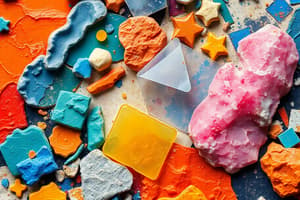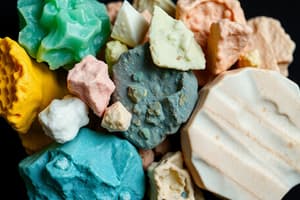Podcast
Questions and Answers
What is the main goal of the heating process mentioned in the text?
What is the main goal of the heating process mentioned in the text?
- To decrease the density of the ceramic
- To maximize the strength by obtaining a compact and dense internal structure (correct)
- To change the color of the ceramic
- To increase the size of the object
Which of the following is NOT a characteristic of most ceramics according to the text?
Which of the following is NOT a characteristic of most ceramics according to the text?
- Thermal insulators
- Conductive (correct)
- Oxidation-resistant
- Brittle
In addition to art sculptures and kitchenware, where else are ceramics commonly found?
In addition to art sculptures and kitchenware, where else are ceramics commonly found?
- In clothing manufacturing
- In automotive engines
- In jewelry making
- As building materials (correct)
What are some lesser-known uses of ceramics mentioned in the text?
What are some lesser-known uses of ceramics mentioned in the text?
What might be a future use of ceramics?
What might be a future use of ceramics?
What is the main difference between traditional ceramics and most industrial ceramics?
What is the main difference between traditional ceramics and most industrial ceramics?
What is the purpose of adding small amounts of wax during the manufacturing of ceramics?
What is the purpose of adding small amounts of wax during the manufacturing of ceramics?
What is the role of densification in the manufacturing of ceramics?
What is the role of densification in the manufacturing of ceramics?
How are impurities, including water, removed from ceramic powder during manufacturing?
How are impurities, including water, removed from ceramic powder during manufacturing?
What happens to the powder particles as a ceramic object is heated in an electric furnace?
What happens to the powder particles as a ceramic object is heated in an electric furnace?
Flashcards
What is the primary goal of heating ceramics?
What is the primary goal of heating ceramics?
The primary objective of heating ceramics is to create a strong, compact, and dense internal structure. This process, known as densification, greatly enhances the material's strength.
What is a common characteristic of ceramics?
What is a common characteristic of ceramics?
Most ceramics are generally poor conductors of electricity and heat. This is a key difference from metals, which are known for their conductivity.
Where else are ceramics commonly found besides art and kitchens?
Where else are ceramics commonly found besides art and kitchens?
Besides artistic creations and kitchenware, ceramics are extensively used in construction to create durable and resilient building materials. They are often incorporated into bricks, tiles, and even some types of concrete blends.
What are some lesser-known applications of ceramics?
What are some lesser-known applications of ceramics?
Signup and view all the flashcards
What are some potential future applications of ceramics?
What are some potential future applications of ceramics?
Signup and view all the flashcards
What is the key difference between traditional and industrial ceramics?
What is the key difference between traditional and industrial ceramics?
Signup and view all the flashcards
What is the purpose of adding wax during ceramics manufacturing?
What is the purpose of adding wax during ceramics manufacturing?
Signup and view all the flashcards
What is the role of densification in ceramic manufacturing?
What is the role of densification in ceramic manufacturing?
Signup and view all the flashcards
How are impurities removed during ceramic manufacturing?
How are impurities removed during ceramic manufacturing?
Signup and view all the flashcards
What happens to powder particles when a ceramic is heated?
What happens to powder particles when a ceramic is heated?
Signup and view all the flashcards
Study Notes
Ceramics Overview
- Ceramics are commonly found in art sculptures, kitchenware, and other applications beyond these, such as space shuttles and biomedical implants.
Characteristics of Ceramics
- Most ceramics are not electrically conductive, non-metallic, and non-magnetic.
- A characteristic that most ceramics do not possess is being electrically conductive.
Heating Process
- The main goal of the heating process is to remove impurities, including water, and to densify the ceramic material.
Industrial Ceramics
- The main difference between traditional ceramics and most industrial ceramics lies in their manufacturing process.
Manufacturing Process
- Small amounts of wax are added during the manufacturing process to help bind the ceramic powder particles together.
- Densification plays a crucial role in the manufacturing process as it strengthens the ceramic material.
- Impurities, including water, are removed from ceramic powder through a process called dehydration.
- As a ceramic object is heated in an electric furnace, the powder particles bond together, forming a solid mass.
Future of Ceramics
- A potential future use of ceramics could be in the development of advanced biomedical implants.
Studying That Suits You
Use AI to generate personalized quizzes and flashcards to suit your learning preferences.




